
- MVC 框架教程
- MVC 框架 - 首頁
- MVC 框架 - 簡介
- MVC 框架 - 架構
- MVC 框架 - ASP.NET 表單
- MVC 框架 - 第一個應用程式
- MVC 框架 - 資料夾
- MVC 框架 - 模型
- MVC 框架 - 控制器
- MVC 框架 - 檢視
- MVC 框架 - 佈局
- MVC 框架 - 路由引擎
- MVC 框架 - 操作過濾器
- 高階示例
- MVC 框架 - Ajax 支援
- MVC 框架 - 打包
- 異常處理
- MVC 框架有用資源
- 問答
- MVC 框架 - 快速指南
- MVC 框架 - 資源
- MVC 框架 - 討論
MVC 框架 - 高階示例
在第一章中,我們學習了控制器和檢視在 MVC 中如何互動。在本教程中,我們將更進一步,學習如何使用模型並建立一個高階應用程式來建立、編輯、刪除和檢視應用程式中使用者的列表。
建立高階 MVC 應用程式
步驟 1 - 選擇檔案 → 新建 → 專案 → ASP.NET MVC Web 應用程式。將其命名為 AdvancedMVCApplication。單擊確定。在下一個視窗中,選擇模板為 Internet 應用程式,檢視引擎為 Razor。注意,這次我們使用的是模板,而不是空應用程式。
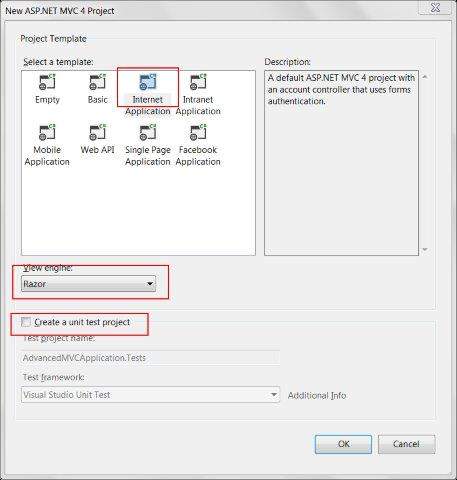
這將建立一個新的解決方案專案,如下面的螢幕截圖所示。由於我們使用的是預設的 ASP.NET 主題,因此它包含示例檢視、控制器、模型和其他檔案。
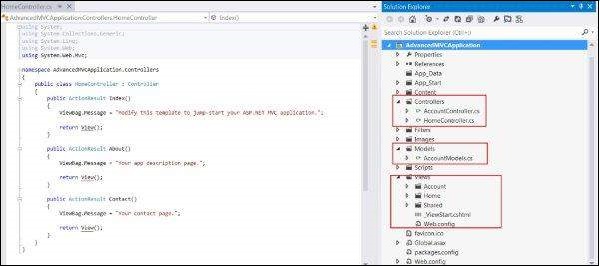
步驟 2 - 構建解決方案並執行應用程式以檢視其預設輸出,如下面的螢幕截圖所示。

步驟 3 - 新增一個新的模型,它將定義使用者資料的結構。右鍵單擊 Models 資料夾,然後單擊新增 → 類。將其命名為 UserModel 並單擊新增。
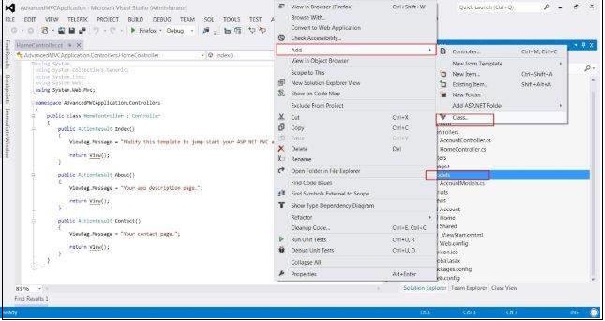
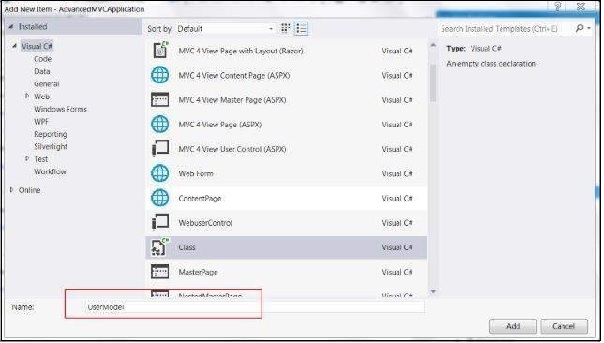
步驟 4 - 將以下程式碼複製到新建立的 UserModel.cs 中。
using System;
using System.ComponentModel;
using System.ComponentModel.DataAnnotations;
using System.Web.Mvc.Html;
namespace AdvancedMVCApplication.Models {
public class UserModels {
[Required]
public int Id { get; set; }
[DisplayName("First Name")]
[Required(ErrorMessage = "First name is required")]
public string FirstName { get; set; }
[Required]
public string LastName { get; set; }
public string Address { get; set; }
[Required]
[StringLength(50)]
public string Email { get; set; }
[DataType(DataType.Date)]
public DateTime DOB { get; set; }
[Range(100,1000000)]
public decimal Salary { get; set; }
}
}
在上面的程式碼中,我們指定了使用者模型的所有引數、它們的資料型別以及驗證,例如必填欄位和長度。
現在我們已經準備好使用者模型來儲存資料,我們將建立一個類檔案 Users.cs,其中將包含檢視使用者、新增、編輯和刪除使用者的方法。
步驟 5 - 右鍵單擊 Models 並單擊新增 → 類。將其命名為 Users。這將在 Models 中建立 users.cs 類。將以下程式碼複製到 users.cs 類中。
using System;
using System.Collections.Generic;
using System.EnterpriseServices;
namespace AdvancedMVCApplication.Models {
public class Users {
public List UserList = new List();
//action to get user details
public UserModels GetUser(int id) {
UserModels usrMdl = null;
foreach (UserModels um in UserList)
if (um.Id == id)
usrMdl = um;
return usrMdl;
}
//action to create new user
public void CreateUser(UserModels userModel) {
UserList.Add(userModel);
}
//action to udpate existing user
public void UpdateUser(UserModels userModel) {
foreach (UserModels usrlst in UserList) {
if (usrlst.Id == userModel.Id) {
usrlst.Address = userModel.Address;
usrlst.DOB = userModel.DOB;
usrlst.Email = userModel.Email;
usrlst.FirstName = userModel.FirstName;
usrlst.LastName = userModel.LastName;
usrlst.Salary = userModel.Salary;
break;
}
}
}
//action to delete exising user
public void DeleteUser(UserModels userModel) {
foreach (UserModels usrlst in UserList) {
if (usrlst.Id == userModel.Id) {
UserList.Remove(usrlst);
break;
}
}
}
}
}
一旦我們有了 UserModel.cs 和 Users.cs,我們將為我們的模型新增檢視,用於檢視使用者、新增、編輯和刪除使用者。首先讓我們建立一個檢視來建立一個使用者。
步驟 6 - 右鍵單擊 Views 資料夾,然後單擊新增 → 檢視。
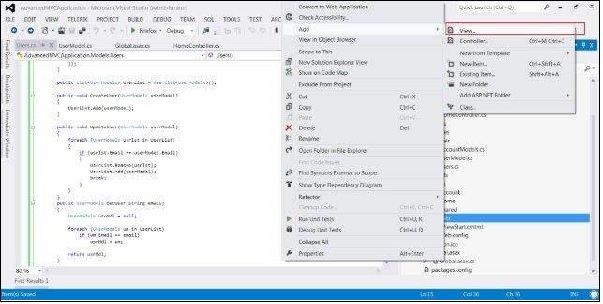
步驟 7 - 在下一個視窗中,選擇檢視名稱為 UserAdd,檢視引擎為 Razor,並選中“建立強型別檢視”複選框。

步驟 8 - 單擊新增。這將預設建立以下 CSHML 程式碼,如下所示:
@model AdvancedMVCApplication.Models.UserModels
@{
ViewBag.Title = "UserAdd";
}
<h2>UserAdd</h2>
@using (Html.BeginForm()) {
@Html.ValidationSummary(true)
<fieldset>
<legend>UserModels</legend>
<div class = "editor-label">
@Html.LabelFor(model => model.FirstName)
</div>
<div class = "editor-field">
@Html.EditorFor(model => model.FirstName)
@Html.ValidationMessageFor(model => model.FirstName)
</div>
<div class = "editor-label">
@Html.LabelFor(model => model.LastName)
</div>
<div class = "editor-field">
@Html.EditorFor(model => model.LastName)
@Html.ValidationMessageFor(model => model.LastName)
</div>
<div class = "editor-label">
@Html.LabelFor(model => model.Address)
</div>
<div class = "editor-field">
@Html.EditorFor(model => model.Address)
@Html.ValidationMessageFor(model => model.Address)
</div>
<div class = "editor-label">
@Html.LabelFor(model => model.Email)
</div>
<div class = "editor-field">
@Html.EditorFor(model => model.Email)
@Html.ValidationMessageFor(model => model.Email)
</div>
<div class = "editor-label">
@Html.LabelFor(model => model.DOB)
</div>
<div class = "editor-field">
@Html.EditorFor(model => model.DOB)
@Html.ValidationMessageFor(model => model.DOB)
</div>
<div class = "editor-label">
@Html.LabelFor(model => model.Salary)
</div>
<div class = "editor-field">
@Html.EditorFor(model => model.Salary)
@Html.ValidationMessageFor(model => model.Salary)
</div>
<p>
<input type = "submit" value = "Create" />
</p>
</fieldset>
}
<div>
@Html.ActionLink("Back to List", "Index")
</div>
@section Scripts {
@Scripts.Render("~/bundles/jqueryval")
}
如您所見,此檢視包含所有欄位屬性的檢視詳細資訊,包括它們的驗證訊息、標籤等。此檢視在我們的最終應用程式中將如下所示。
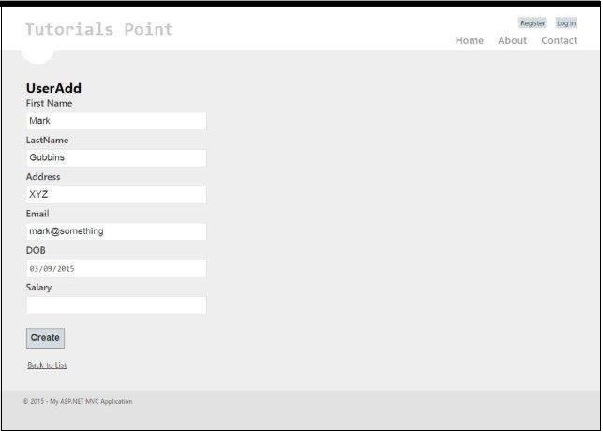
與 UserAdd 類似,現在我們將新增下面給出的另外四個檢視及其程式碼:
Index.cshtml
此檢視將在索引頁面上顯示系統中存在的所有使用者。
@model IEnumerable<AdvancedMVCApplication.Models.UserModels>
@{
ViewBag.Title = "Index";
}
<h2>Index</h2>
<p>
@Html.ActionLink("Create New", "UserAdd")
</p>
<table>
<tr>
<th>
@Html.DisplayNameFor(model => model.FirstName)
</th>
<th>
@Html.DisplayNameFor(model => model.LastName)
</th>
<th>
@Html.DisplayNameFor(model => model.Address)
</th>
<th>
@Html.DisplayNameFor(model => model.Email)
</th>
<th>
@Html.DisplayNameFor(model => model.DOB)
</th>
<th>
@Html.DisplayNameFor(model => model.Salary)
</th>
<th></th>
</tr>
@foreach (var item in Model) {
<tr>
<td>
@Html.DisplayFor(modelItem => item.FirstName)
</td>
<td>
@Html.DisplayFor(modelItem => item.LastName)
</td>
<td>
@Html.DisplayFor(modelItem => item.Address)
</td>
<td>
@Html.DisplayFor(modelItem => item.Email)
</td>
<td>
@Html.DisplayFor(modelItem => item.DOB)
</td>
<td>
@Html.DisplayFor(modelItem => item.Salary)
</td>
<td>
@Html.ActionLink("Edit", "Edit", new { id = item.Id }) |
@Html.ActionLink("Details", "Details", new { id = item.Id }) |
@Html.ActionLink("Delete", "Delete", new { id = item.Id })
</td>
</tr>
}
</table>
此檢視在我們的最終應用程式中將如下所示。
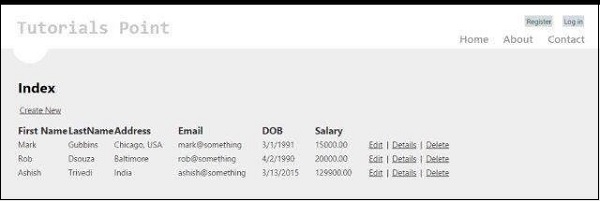
Details.cshtml
當我們單擊使用者記錄時,此檢視將顯示特定使用者的詳細資訊。
@model AdvancedMVCApplication.Models.UserModels
@{
ViewBag.Title = "Details";
}
<h2>Details</h2>
<fieldset>
<legend>UserModels</legend>
<div class = "display-label">
@Html.DisplayNameFor(model => model.FirstName)
</div>
<div class = "display-field">
@Html.DisplayFor(model => model.FirstName)
</div>
<div class = "display-label">
@Html.DisplayNameFor(model => model.LastName)
</div>
<div class = "display-field">
@Html.DisplayFor(model => model.LastName)
</div>
<div class = "display-label">
@Html.DisplayNameFor(model => model.Address)
</div>
<div class = "display-field">
@Html.DisplayFor(model => model.Address)
</div>
<div class = "display-label">
@Html.DisplayNameFor(model => model.Email)
</div>
<div class = "display-field">
@Html.DisplayFor(model => model.Email)
</div>
<div class = "display-label">
@Html.DisplayNameFor(model => model.DOB)
</div>
<div class = "display-field">
@Html.DisplayFor(model => model.DOB)
</div>
<div class = "display-label">
@Html.DisplayNameFor(model => model.Salary)
</div>
<div class = "display-field">
@Html.DisplayFor(model => model.Salary)
</div>
</fieldset>
<p>
@Html.ActionLink("Edit", "Edit", new { id = Model.Id }) |
@Html.ActionLink("Back to List", "Index")
</p>
此檢視在我們的最終應用程式中將如下所示。

Edit.cshtml
此檢視將顯示用於編輯現有使用者詳細資訊的編輯表單。
@model AdvancedMVCApplication.Models.UserModels
@{
ViewBag.Title = "Edit";
}
<h2>Edit</h2>
@using (Html.BeginForm()) {
@Html.AntiForgeryToken()
@Html.ValidationSummary(true)
<fieldset>
<legend>UserModels</legend>
@Html.HiddenFor(model => model.Id)
<div class = "editor-label">
@Html.LabelFor(model => model.FirstName)
</div>
<div class = "editor-field">
@Html.EditorFor(model => model.FirstName)
@Html.ValidationMessageFor(model => model.FirstName)
</div>
<div class = "editor-label">
@Html.LabelFor(model => model.LastName)
</div>
<div class = "editor-field">
@Html.EditorFor(model => model.LastName)
@Html.ValidationMessageFor(model => model.LastName)
</div>
<div class = "editor-label">
@Html.LabelFor(model => model.Address)
</div>
<div class = "editor-field">
@Html.EditorFor(model => model.Address)
@Html.ValidationMessageFor(model => model.Address)
</div>
<div class = "editor-label">
@Html.LabelFor(model => model.Email)
</div>
<div class = "editor-field">
@Html.EditorFor(model => model.Email)
@Html.ValidationMessageFor(model => model.Email)
</div>
<div class = "editor-label">
@Html.LabelFor(model => model.DOB)
</div>
<div class = "editor-field">
@Html.EditorFor(model => model.DOB)
@Html.ValidationMessageFor(model => model.DOB)
</div>
<div class = "editor-label">
@Html.LabelFor(model => model.Salary)
</div>
<div class = "editor-field">
@Html.EditorFor(model => model.Salary)
@Html.ValidationMessageFor(model => model.Salary)
</div>
<p>
<input type = "submit" value = "Save" />
</p>
</fieldset>
}
<div>
@Html.ActionLink("Back to List", "Index")
</div>
@section Scripts {
@Scripts.Render("~/bundles/jqueryval")
}
此檢視在我們的應用程式中將如下所示。

Delete.cshtml
此檢視將顯示用於刪除現有使用者的表單。
@model AdvancedMVCApplication.Models.UserModels
@{
ViewBag.Title = "Delete";
}
<h2>Delete</h2>
<h3>Are you sure you want to delete this?</h3>
<fieldset>
<legend>UserModels</legend>
<div class = "display-label">
@Html.DisplayNameFor(model => model.FirstName)
</div>
<div class = "display-field">
@Html.DisplayFor(model => model.FirstName)
</div>
<div class = "display-label">
@Html.DisplayNameFor(model => model.LastName)
</div>
<div class = "display-field">
@Html.DisplayFor(model => model.LastName)
</div>
<div class = "display-label">
@Html.DisplayNameFor(model => model.Address)
</div>
<div class = "display-field">
@Html.DisplayFor(model => model.Address)
</div>
<div class = "display-label">
@Html.DisplayNameFor(model => model.Email)
</div>
<div class = "display-field">
@Html.DisplayFor(model => model.Email)
</div>
<div class = "display-label">
@Html.DisplayNameFor(model => model.DOB)
</div>
<div class = "display-field">
@Html.DisplayFor(model => model.DOB)
</div>
<div class = "display-label">
@Html.DisplayNameFor(model => model.Salary)
</div>
<div class = "display-field">
@Html.DisplayFor(model => model.Salary)
</div>
</fieldset>
@using (Html.BeginForm()) {
@Html.AntiForgeryToken()
<p>
<input type = "submit" value = "Delete" /> |
@Html.ActionLink("Back to List", "Index")
</p>
}
此檢視在我們的最終應用程式中將如下所示。
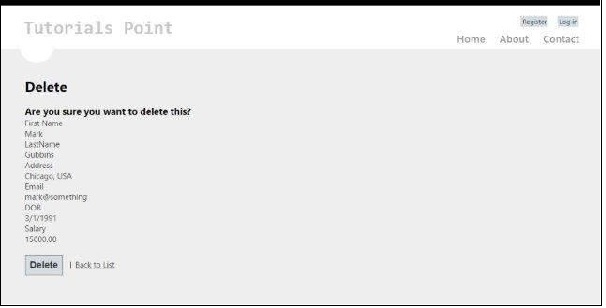
步驟 9 - 我們已經在應用程式中添加了模型和檢視。現在,我們最終將為我們的檢視新增一個控制器。右鍵單擊 Controllers 資料夾,然後單擊新增 → 控制器。將其命名為 UserController。
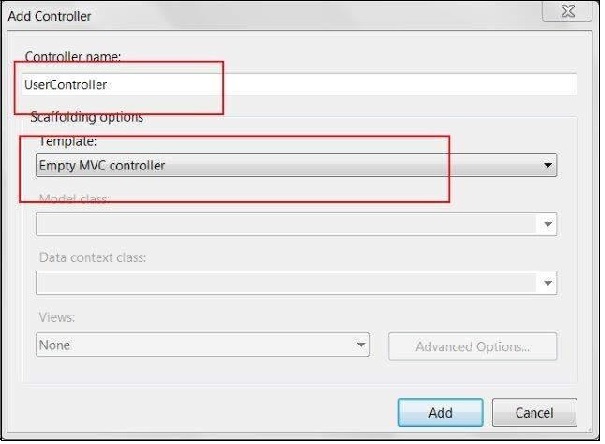
預設情況下,您的控制器類將使用以下程式碼建立:
using System;
using System.Collections.Generic;
using System.Linq;
using System.Web;
using System.Web.Mvc;
using AdvancedMVCApplication.Models;
namespace AdvancedMVCApplication.Controllers {
public class UserController : Controller {
private static Users _users = new Users();
public ActionResult Index() {
return View(_users.UserList);
}
}
}
在上面的程式碼中,Index 方法將在渲染索引頁面上的使用者列表時使用。
步驟 10 - 右鍵單擊 Index 方法並選擇建立檢視,為我們的索引頁面建立檢視(它將列出所有使用者並提供建立新使用者的選項)。
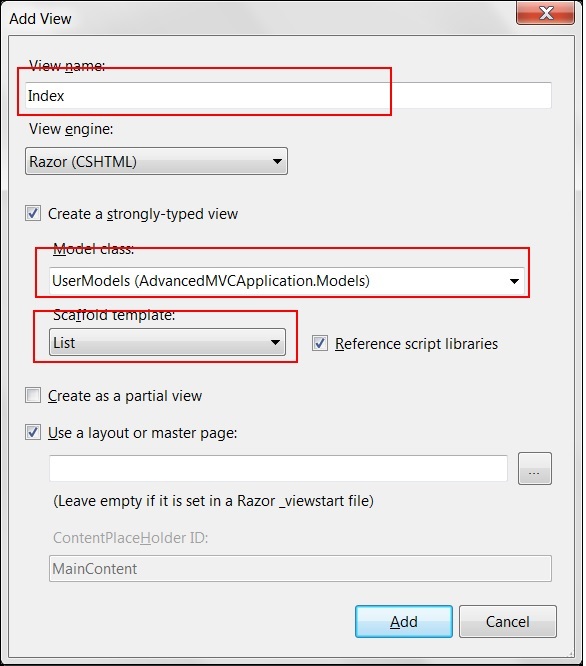
步驟 11 - 現在在 UserController.cs 中新增以下程式碼。在此程式碼中,我們正在為不同的使用者操作建立操作方法,並返回我們之前建立的相應檢視。
我們將為每個操作新增兩種方法:GET 和 POST。HttpGet 將用於獲取資料並呈現資料。HttpPost 將用於建立/更新資料。例如,當我們新增新使用者時,我們需要一個表單來新增使用者,這是一個 GET 操作。一旦我們填寫表單並提交這些值,我們就需要 POST 方法。
//Action for Index View
public ActionResult Index() {
return View(_users.UserList);
}
//Action for UserAdd View
[HttpGet]
public ActionResult UserAdd() {
return View();
}
[HttpPost]
public ActionResult UserAdd(UserModels userModel) {
_users.CreateUser(userModel);
return View("Index", _users.UserList);
}
//Action for Details View
[HttpGet]
public ActionResult Details(int id) {
return View(_users.UserList.FirstOrDefault(x => x.Id == id));
}
[HttpPost]
public ActionResult Details() {
return View("Index", _users.UserList);
}
//Action for Edit View
[HttpGet]
public ActionResult Edit(int id) {
return View(_users.UserList.FirstOrDefault(x=>x.Id==id));
}
[HttpPost]
public ActionResult Edit(UserModels userModel) {
_users.UpdateUser(userModel);
return View("Index", _users.UserList);
}
//Action for Delete View
[HttpGet]
public ActionResult Delete(int id) {
return View(_users.UserList.FirstOrDefault(x => x.Id == id));
}
[HttpPost]
public ActionResult Delete(UserModels userModel) {
_users.DeleteUser(userModel);
return View("Index", _users.UserList);
} sers.UserList);
步驟 12 - 最後要做的是轉到 App_Start 資料夾中的 RouteConfig.cs 檔案並將預設控制器更改為 User。
defaults: new { controller = "User", action = "Index", id = UrlParameter.Optional }
這就是使我們的高階應用程式執行所需的一切。
步驟 13 - 現在執行應用程式。您將能夠看到一個應用程式,如下面的螢幕截圖所示。您可以執行新增、檢視、編輯和刪除使用者的所有功能,就像我們在之前的螢幕截圖中看到的那樣。
